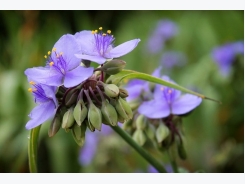How to Grow Coconut Palm

Few trees are more exotic than the coconut palm (Cocos nucifera Linn.). This regal tree produces edible seeds – coconuts. Unfortunately, coconut palms are hardy only in USDA plant hardiness zone 11 and 12.
They need minimum temperatures of about 72 degrees and grow best when temperatures range between 85 and 95 degrees.
You can try growing them indoors, but they probably won’t bear fruit. If you live in a warm, tropical area, you can plant coconut palms outdoors at any time of the year, although the warm, rainy months of summer are best. The trees grow slowly and may not produce fruit for several years. At maturity, they can reach heights of 80 to 100 feet.
Propagating Coconut Palm
The simplest way to grow coconut palms is from a potted nursery plant, but you can grow them from seed. Start with a coconut – the kind you find in the grocery store will do. Place the coconut in a bucket filled with lukewarm water. Use a rock or weight to keep the coconut submerged under water and leave it for three or four days. This soaking softens the coconut and accelerates the germination process.
Remove the coconut from the water. Fill a large zip-top plastic bag with 1 cup of water. Place the coconut in the plastic bag and seal it. Store it in a warm, dark location, such as near a water heater. Check it every week. The seed will germinate and produce roots and a sprout within a few weeks or up to three months.
Once the roots begin to grow, gently wrap them in a damp paper towel and place the coconut back in the bag. It’s time to transplant the coconut when the sprout grows to about the size of your finger and the roots are about 6 to 8 inches long. To plant your coconut palm in a pot, select a pot that holds at least 10 gallons of soil. Fill it with a potting soil designed for cactus or make your own mix by combining one part regular potting soil with one part sand. Add a few handfuls of fine gravel. Plant the coconut so part of the sprout is beneath the soil.
To plant a coconut seed in the ground, select a location that has sandy, loose, well-draining soil. In low-lying areas, plant coconuts in raised beds to improve drainage.
Whether you propagate your coconut palm from seed or from a nursery transplant, coconut palms need frequent moisture. Water them at least weekly so the soil stays consistently moist. Coconut palms should be planted in an area that gets full sun. A warm, protected area is ideal. If you like, you can create a mini-greenhouse around your young plant. Drive several bamboo stakes into the ground 6 inches from the plant to create a sort of fence around the plant. Wrap plastic wrap around the bamboo sticks and across the top to create an enclosure. Remove this greenhouse once the tree stands 12 inches tall.
Coconut palms are subject to phosphorus, nitrogen, manganese and boron deficiencies, which typically present themselves as yellowed leaves or slow growth. To prevent nutrient deficiencies, fertilize your coconut palm every two months with a fertilizer made for palm trees. Apply the fertilizer with a rotary spreader throughout the area under the crown of the tree. Apply it at a rate of 1 pound per 100 square feet of soil.
Coconut Palm Pests and Diseases
Coconut palms are plagued by several disease problems. The most common one is “lethal yellow” (LY), which has slowly spread up the coast of Florida, killing off many native and commercial plantings. Yellowing leaves, dropping fruit and slow death are the most likely symptoms. If you live in an area prone to LY, plant a disease-resistant variety such as Malayan Dwarf. Infected trees may be treated with antibiotics, but you must treat the tree every four months for the rest of its life. In a home garden, it’s usually best to remove infected trees.
Fungal bud rot causes spots on the leaves or the leaves become gray. As the fungus infects the buds, they shrivel, yellow and drop and have a foul odor. The disease is most common after heavy rains or in poorly draining soil. Plant palm coconuts in full sun, in well-draining soil and treat them with fosetyl-Al to prevent fungal bud rot. Once infected, the trees should be removed.
Harvesting Coconut Trees
Your coconut palm may begin producing fruit five to seven years after planting. The coconuts take 7 to 12 months to mature from bud set. Harvest them at seven months for drinking. Harvest at 12 months if you plan to dry the coconut.
Related news
Tools

Phối trộn thức ăn chăn nuôi

Pha dung dịch thủy canh

Định mức cho tôm ăn

Phối trộn phân bón NPK

Xác định tỷ lệ tôm sống

Chuyển đổi đơn vị phân bón

Xác định công suất sục khí

Chuyển đổi đơn vị tôm

Tính diện tích nhà kính

Tính thể tích ao




 How to Grow Weeping Willow Trees
How to Grow Weeping Willow Trees  How to Grow Melampodium (Butter Daisy)
How to Grow Melampodium (Butter Daisy)